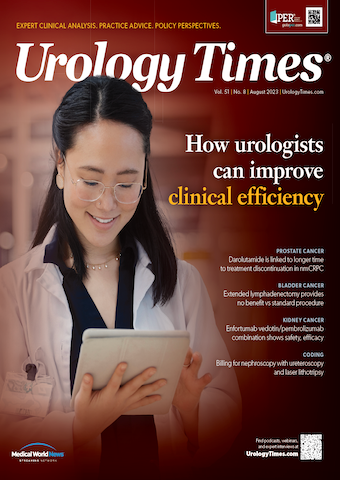News
Article
Urology Times Journal
Enfortumab vedotin/pembrolizumab combo shows safety, efficacy in metastatic urothelial carcinoma
Author(s):
"In EV-103 dose escalation/cohort A, the safety profile of the combination was manageable, with no new safety concerns observed at nearly 4 years of follow-up," said Shilpa Gupta, MD.
Combination treatment with enfortumab vedotin-ejfv (Padcev, EV) and pembrolizumab (Keytruda) showed clinically meaningful efficacy as well as a manageable safety profile in patients with cisplatin-ineligible locally advanced or metastatic urothelial carcinoma, according to data presented at the 2023 American Society of Clinical Oncology Annual Meeting.1
Shilpa Gupta, MD

“As a background, despite [gemcitabine/carboplatin] as the frontline treatment for cisplatin-ineligible patients with locally advanced and metastatic urothelial cancer, there is a significant need to further improve outcomes. Avelumab [Bavencio] maintenance is only indicated in patients who do not progress after gem/carbo, and PD-1 or PD-L1 monotherapy is only indicated in a very select group of patients,” explained first author Shilpa Gupta, MD, director of Genitourinary Medical Oncology at Taussig Cancer Institute and co-leader of the Genitourinary Oncology Program at Cleveland Clinic, Cleveland, Ohio.
The FDA approved the combination of EV and pembrolizumab in the treatment of cisplatin-ineligible locally advanced or metastatic urothelial carcinoma based on findings from EV-103 (NCT03288545) dose-escalation cohort, cohort A, and cohort K, which showed that the combination has rapid and durable responses as well as a manageable safety profile in patients with previously untreated urothelial cancer. For the present study, Gupta presented an update on the results of dose escalation/cohort A after a median follow-up of 47 months.
“Enfortumab vedotin has a multifaceted mechanism of action due to the intracellular release of MMAE, which leads to direct cytotoxicity of the nectin-4-containing cancer cells, as well as induces the hallmark of immunogenic cell death…When combined with a checkpoint inhibitor there’s believed to be a complementary activity for further immune engagement and hence pembrolizumab is a rational partner for this combination,” Gupta said.
The analysis included a total of 45 patients, who received EV, 1.25 mg/kg intravenously (IV) on days 1 and 8, and pembrolizumab, 200 mg IV on day 1 of every 3-week cycle. Primary end points included adverse events (AEs) and lab abnormalities, and key secondary end points included confirmed objective response rate (ORR), duration of response (DOR), profession-free survival, and overall survival (OS).
Most of the patients were male (36, 80.0%), and median age was 69.0 years. Nearly all the patients were Caucasian (42, 93.3%), with ECOG performance status of 0, 1, or 2 in 15 (33.3%), 22 (48.9%), and 8 (17.8%) patients, respectively. Fourteen patients (31.1%) had liver metastases, and 38 patients (84.4%) had visceral disease.
After nearly 4 years of follow-up 40% of patients remained on study. All had discontinued treatment. Median treatment duration was 7 months, and median number of treatment cycles was 9. Reason for treatment discontinuation included progressive disease in 19 patients (42.2%), AEs in 15 patients (33.3%), patient decision in 9 patients (20.0%), and physician decision or other in 1 patient each (2.2%). Death was most common reason for study discontinuation, occurring in 22 patients (48.9%).
ORR was 73.3% (95% CI, 59.1-85.4), and disease control rate was 84.4% (95% CI, 70.5-93.5). Median DOR was 22.1 months, and median OS was 26.1 months.
Any-grade AEs occurred in 43 patients (95.6%) and included peripheral sensory neuropathy (25 patients, 55.6%), fatigue (23 patients, 51.1%), alopecia (22 patients, 48.9%), diarrhea (21 patients, 46.7%), decreased appetite (18 patients, 40.0%), maculo-papular rash (16 patients, 35.6%), pruritus (15 patients, 33.3%), and dysgeusia (15 patients, 33.3%). AEs of grade 3 or higher occurred in 29 patients (64.4%) and included increased lipase (8 patients, 17.8%); maculo-papular rash in 5 patients (11.1%); fatigue in 5 patients (11.1%); neutropenia, anemia, hyperglycemia, and increased amylase in 4 patients each (8.9%); and increased transaminases in 3 patients (6.7%).
Treatment-related AEs of special interested for EV included skin reactions of any grade in 30 patients (66.7%) and grade 3 or higher in 9 patients (20.0%), as well as peripheral neuropathy in 28 patients (62.2%). The investigators noted that treatment-related AEs for EV were consistent with previously reported results.
The most common treatment-emergent AEs of special interest for pembrolizumab included severe skin reaction of any grade in 11 patients (24.4%) and grade 3 or higher in 10 patients (22.2%).
Of patients receiving subsequent cancer-related therapy(ies), the most common was systemic therapy in 22 patients (48.9%).
“In EV-103 dose escalation/cohort A, the safety profile of the combination was manageable, with no new safety concerns observed at nearly 4 years of follow-up. EV and pembrolizumab demonstrated clinically meaningful efficacy, with a high confirmed high confirmed overall response rates, durable responses and a median survival exceeding two years in this patient population,” Gupta said in her concluding remarks.
Reference
1. Gupta S, Rosenberg JE, McKay RR, et al. Study EV-103 dose escalation/cohort A: Long-term outcome of enfortumab vedotin + pembrolizumab in first-line (1L) cisplatin-ineligible locally advanced or metastatic urothelial carcinoma (la/mUC) with nearly 4 years of follow-up. J Clin Oncol. 2023;41(suppl):4505. doi:10.1200/JCO.2023.41.16_suppl.4505

Newsletter
Stay current with the latest urology news and practice-changing insights — sign up now for the essential updates every urologist needs.



























